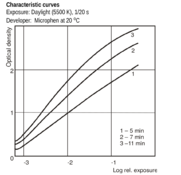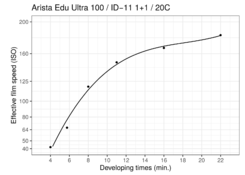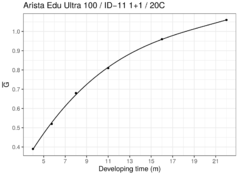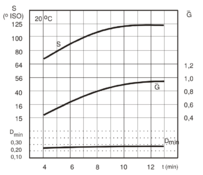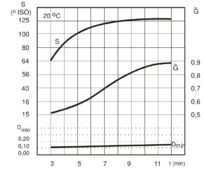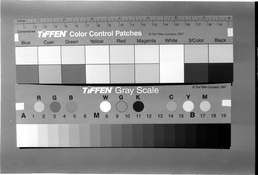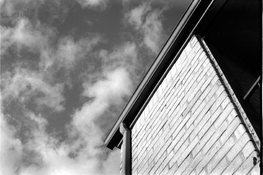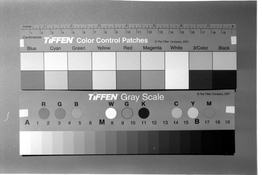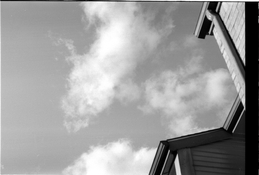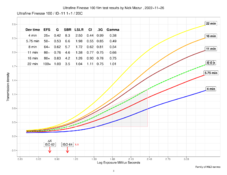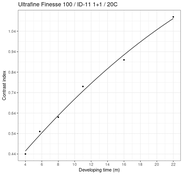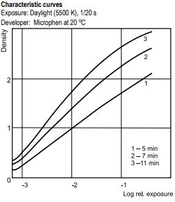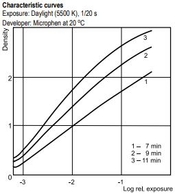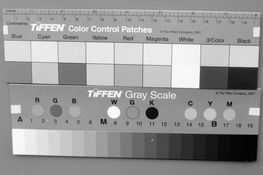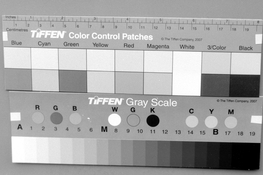aparat
Member
As film prices continue to climb, a lot of photographers reach for the least expensive options. Currently, if purchasing in bulk, the Arista Edu Ultra and Ultrafine Finesse are among the least expensive 35 mm films on the market (at least in the US). At Photo Warehouse, a 100 ft. bulk roll sells for:
I ran a six-curve family test (for 4, 5:45, 8, 11, 16, and 22 minutes) for Arista Edu Ultra 100, Arista Edu Ultra 400, Ultrafine Finesse 100, and Ultrafine Finesse 400, and developed them in the same tank, in Ilford ID-11 1+1, in a rotary processor at 20C. I used Ilford ID-11 simply because I had just made a fresh five-liter batch and because it's a great, very popular, all-rounder. I ran the test twice and averaged the density readings for the final analysis. There’s a lot of data to go through so I will be posting my analysis in installments.
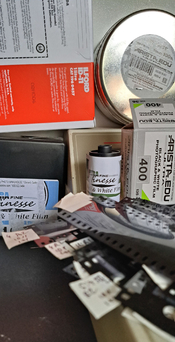
First, let’s take a look at the Arista Edu Ultra 100. I grew up behind the Iron Curtain, where Foma (apparently, the manufacturer of Arista Edu Ultra films) and ORWO were highly sought-after brands of photographic materials.
This is a conventional, panchromatic B&W film. It is coated on a gray or gray-blue cellulose triacetate base, 0,135 mm thick. It handles very well. It curles prior to processing, but dries flat. I have found no emulsion defects in this batch. Base fog density is respectable, ranging from 0.3 to 0.35 in my test. The film produces a family of well-formed curves, with a short toe, nice separation along the entire tonal range, and a sizable increase in film speed (about 2 stops) over the six developing times. The ISO speed, according to my test, is around ISO 95. Interestingly, it appears to be around 1/2 ro 3/4 of a stop faster than the CatLABS X FILM 320 Pro, another economically priced film, tested in this thread. More data and sample photographs coming up soon.
Your comments and photographs are highly appreciated!
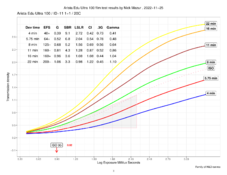
- Ultrafine Finesse 100: $60.95
- Ultrafine Finesse 400: $61.95
- Arista Edu Ultra 100 and 400: $63.99
I ran a six-curve family test (for 4, 5:45, 8, 11, 16, and 22 minutes) for Arista Edu Ultra 100, Arista Edu Ultra 400, Ultrafine Finesse 100, and Ultrafine Finesse 400, and developed them in the same tank, in Ilford ID-11 1+1, in a rotary processor at 20C. I used Ilford ID-11 simply because I had just made a fresh five-liter batch and because it's a great, very popular, all-rounder. I ran the test twice and averaged the density readings for the final analysis. There’s a lot of data to go through so I will be posting my analysis in installments.

First, let’s take a look at the Arista Edu Ultra 100. I grew up behind the Iron Curtain, where Foma (apparently, the manufacturer of Arista Edu Ultra films) and ORWO were highly sought-after brands of photographic materials.
This is a conventional, panchromatic B&W film. It is coated on a gray or gray-blue cellulose triacetate base, 0,135 mm thick. It handles very well. It curles prior to processing, but dries flat. I have found no emulsion defects in this batch. Base fog density is respectable, ranging from 0.3 to 0.35 in my test. The film produces a family of well-formed curves, with a short toe, nice separation along the entire tonal range, and a sizable increase in film speed (about 2 stops) over the six developing times. The ISO speed, according to my test, is around ISO 95. Interestingly, it appears to be around 1/2 ro 3/4 of a stop faster than the CatLABS X FILM 320 Pro, another economically priced film, tested in this thread. More data and sample photographs coming up soon.
Your comments and photographs are highly appreciated!









